Your brain produces two powerful chemicals that shape how you feel every day. Serotonin and dopamine are neurotransmitters that play vital roles in regulating mood, motivation, and other bodily functions. People often call them the “happy hormones,” but these brain chemicals work in very different ways.
Serotonin primarily handles mood regulation, emotional well-being, and relaxation, while dopamine drives motivation, reward-seeking behaviors, and feelings of pleasure. Understanding how these chemicals work can help explain why you feel motivated some days and calm others. When these systems get out of balance, it can affect your mental health, sleep, and daily life.
Both neurotransmitters influence mood disorders like depression, but they create different symptoms when levels drop too low. Learning about serotonin and dopamine helps you make better choices about diet, exercise, and lifestyle habits that support your brain chemistry naturally.
Key Takeaways
- Serotonin stabilizes mood and promotes relaxation while dopamine drives motivation and reward-seeking behaviors
- Both chemicals affect mental health conditions like depression but create different symptoms when imbalanced
- Natural methods like proper diet, exercise, and sleep can help support healthy neurotransmitter levels
Serotonin vs Dopamine: Key Differences and Similarities
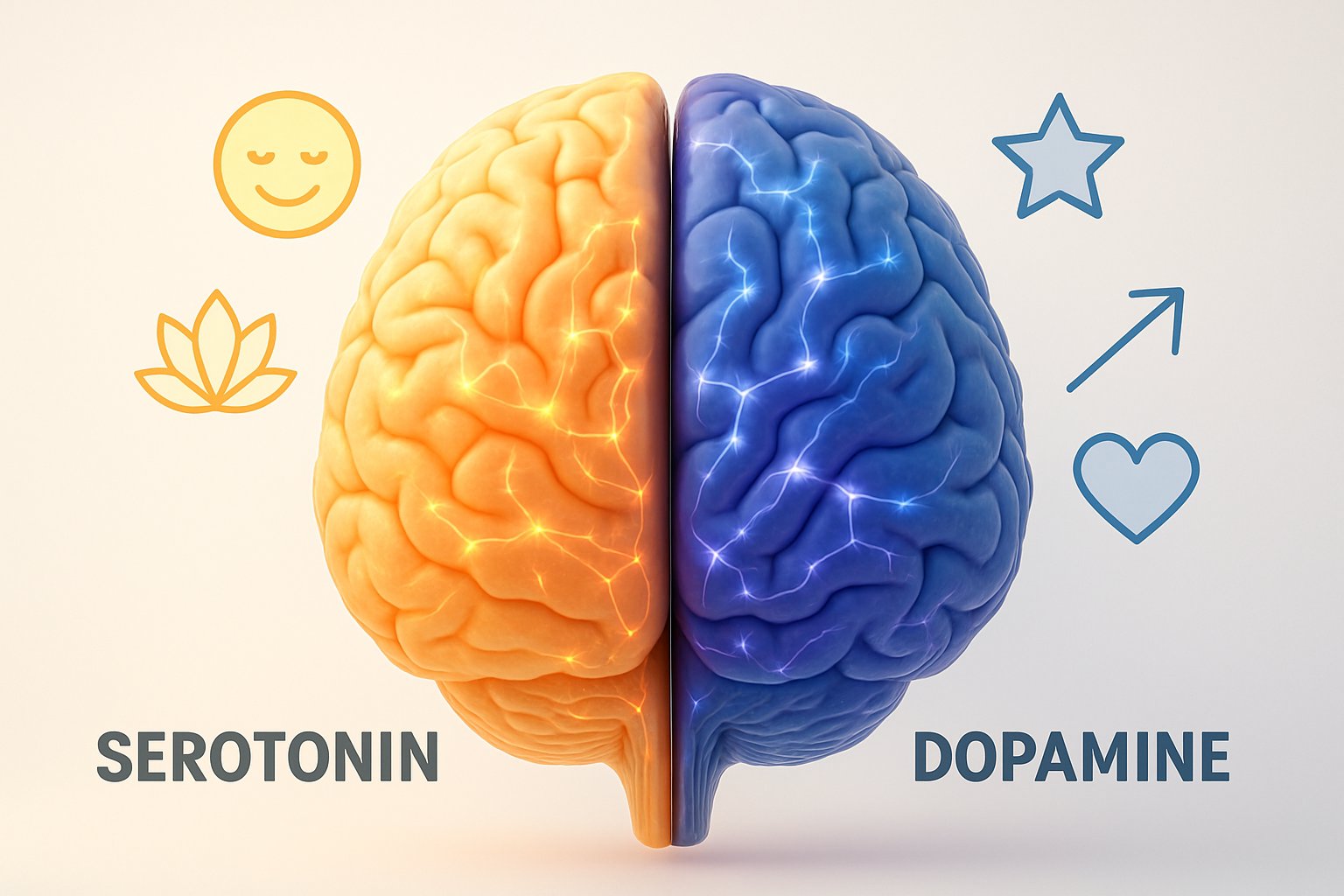
Serotonin and dopamine are neurotransmitters that serve distinct roles in brain chemistry while working together to regulate mood and behavior. Serotonin acts as an inhibitory brain chemical that promotes emotional stability, while dopamine functions as an excitatory neurotransmitter that drives motivation and reward-seeking behavior.
Defining Serotonin and Dopamine
Serotonin is an inhibitory neurotransmitter produced primarily in the brain stem’s raphe nuclei. It regulates mood, sleep, and digestion throughout the body.
Most serotonin exists outside the brain in the gastrointestinal tract. Only about 10% is found in brain tissue, where it influences emotional balance and cognitive function.
Dopamine is an excitatory neurotransmitter concentrated in the midbrain regions. It originates from the ventral tegmental area and substantia nigra.
This brain chemical travels through specific pathways to reach different brain regions. The mesolimbic pathway carries dopamine to areas involved in reward processing, while the mesocortical pathway delivers it to regions responsible for higher cognitive functions.
Both neurotransmitters belong to the monoamine family of brain chemicals. They share similar molecular structures but produce vastly different effects on brain function and behavior.
Major Functions in the Brain
Serotonin promotes emotional balance, sleep, and digestion, while dopamine drives reward-seeking and goal pursuit. These happy chemicals regulate different aspects of mental and physical health.
Serotonin Functions:
- Mood regulation and emotional stability
- Sleep cycle control
- Appetite and digestion management
- Pain sensitivity modulation
- Memory and attention processes
Dopamine Functions:
- Reward system activation
- Motivation and goal-directed behavior
- Movement and motor control
- Focus and attention regulation
- Pleasure and satisfaction experiences
Low serotonin levels link to depression, anxiety, and sleep disorders. Deficient dopamine connects to lack of motivation, difficulty concentrating, and reduced pleasure in activities.
Excess dopamine can cause psychosis and hallucinations in some individuals. Balanced levels of both neurotransmitters support optimal mental health and daily functioning.
Mechanisms of Action
Serotonin works as an inhibitory neurotransmitter that calms neural activity. It binds to specific serotonin receptors throughout the brain and body to reduce excessive stimulation.
This brain chemical balances the effects of excitatory neurotransmitters. It prevents overstimulation that could lead to anxiety, agitation, or mood instability.
Dopamine operates as an excitatory neurotransmitter that increases neural activity. It activates dopamine receptors in reward pathways to create feelings of motivation and pleasure.
The dopamine system responds to anticipated rewards rather than just receiving them. This mechanism drives people to pursue goals and engage in productive behaviors.
| Aspect | Serotonin | Dopamine |
|---|---|---|
| Type | Inhibitory | Excitatory |
| Primary Role | Mood stabilization | Motivation and reward |
| Key Effects | Calm, contentment | Drive, focus |
| Deficiency Issues | Depression, anxiety | Low motivation, poor focus |
How They Work Together
Serotonin can influence dopamine activity, modulating how intensely people respond to rewards and pleasurable experiences. These brain chemicals interact through complex neural networks.
When serotonin levels drop, dopamine may become overactive. This imbalance can contribute to impulsive behavior, aggression, or addiction-seeking patterns.
Balanced serotonin helps regulate dopamine’s reward responses. It prevents excessive reward-seeking while maintaining healthy motivation levels.
Both neurotransmitters influence the same brain regions involved in mood regulation. The nucleus accumbens, hippocampus, and frontal cortex receive signals from both chemical systems.
Animal studies show that lower serotonin combined with elevated dopamine increases aggressive behavior. This research supports the importance of maintaining balance between these brain chemicals.
Healthy lifestyle habits can support both neurotransmitter systems simultaneously. Exercise, sunlight exposure, and social connections naturally boost serotonin and dopamine levels.
Serotonin: The Mood Stabilizer
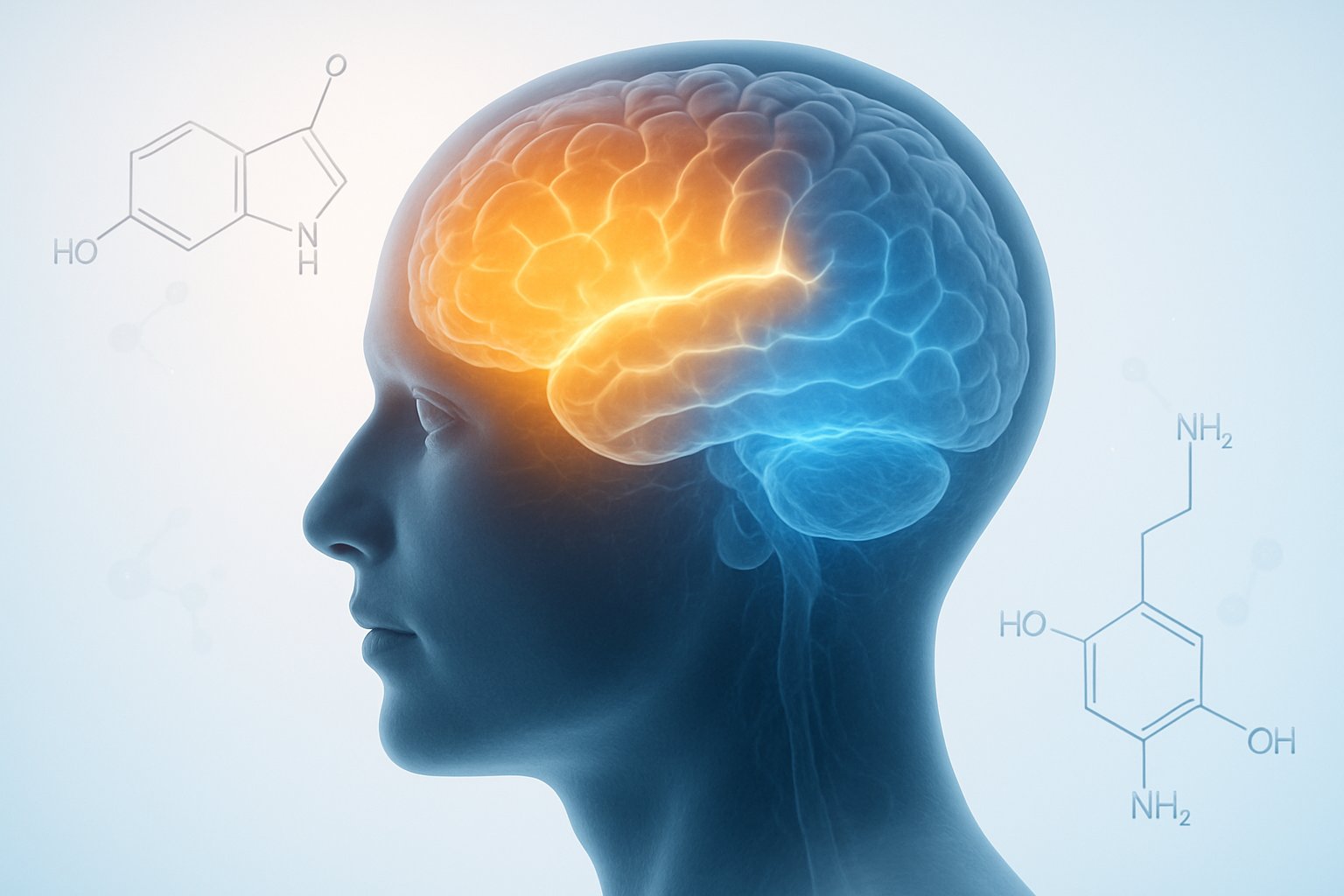
Serotonin acts as the brain’s primary mood stabilizer, maintaining emotional balance and promoting feelings of contentment. This neurotransmitter controls sleep patterns, appetite regulation, and social connections while preventing mood swings and anxiety.
Role in Emotional Regulation
Serotonin serves as the brain’s mood stabilizer, helping people maintain emotional stability throughout daily challenges. Unlike dopamine’s quick bursts of excitement, serotonin provides steady, long-lasting feelings of well-being.
This neurotransmitter prevents dramatic mood swings by keeping emotional responses balanced. When serotonin levels remain stable, people feel more content and peaceful.
Key emotional functions include:
- Managing stress responses
- Reducing anxiety levels
- Promoting feelings of happiness
- Supporting emotional resilience
Low serotonin levels often lead to increased irritability and emotional instability. People may experience heightened sensitivity to stress and difficulty recovering from negative events.
Serotonin deficiency can cause mood swings and feelings of hopelessness. These emotional changes significantly impact daily functioning and relationships.
Effects on Sleep and Appetite
Serotonin plays a crucial role in regulating both sleep cycles and eating patterns. The body needs adequate serotonin levels to produce melatonin, the hormone responsible for healthy sleep.
Serotonin is needed for the body to make melatonin, which controls when people feel tired. Without enough serotonin, sleep quality suffers significantly.
Sleep-related effects:
- Controls sleep-wake cycles
- Influences REM sleep quality
- Affects time needed to fall asleep
- Determines sleep depth
Appetite regulation depends heavily on serotonin balance. This neurotransmitter influences hunger signals and food cravings throughout the day.
Low serotonin can cause carbohydrate cravings and appetite changes. People may eat more sugary foods when serotonin levels drop.
High serotonin levels can reduce appetite and interest in food. Both extremes create challenges for maintaining healthy eating patterns.
Impact on Social Behavior
Serotonin significantly influences how people interact with others and form social connections. This chemical impacts empathy for other people and social bonding abilities.
People with balanced serotonin levels show greater compassion and understanding. They connect more easily with others and maintain healthier relationships.
Social benefits include:
- Enhanced empathy and compassion
- Improved communication skills
- Better conflict resolution
- Stronger emotional bonds
Low serotonin can make social interactions feel overwhelming or unpleasant. People may withdraw from relationships and avoid social situations.
This withdrawal often worsens emotional health problems. Social isolation can create a cycle where low serotonin leads to loneliness, which further reduces serotonin production.
Signs of Serotonin Imbalance
Recognizing serotonin imbalance symptoms helps people seek appropriate treatment early. Signs of low serotonin levels affect multiple areas of physical and mental health.
Common low serotonin symptoms:
- Persistent sadness or depression
- Difficulty sleeping or insomnia
- Increased anxiety levels
- Digestive problems and constipation
- Decreased energy and motivation
Too much serotonin can cause serotonin syndrome, a potentially dangerous condition. This usually happens when people take too much medication that increases serotonin.
Serotonin syndrome symptoms include:
- Rapid heart rate
- High blood pressure
- Severe restlessness
- Hallucinations
- Nausea and vomiting
Both high and low serotonin levels require medical attention. Healthcare providers can test serotonin levels and recommend appropriate treatments to restore balance.
Dopamine: The Reward and Motivation Chemical
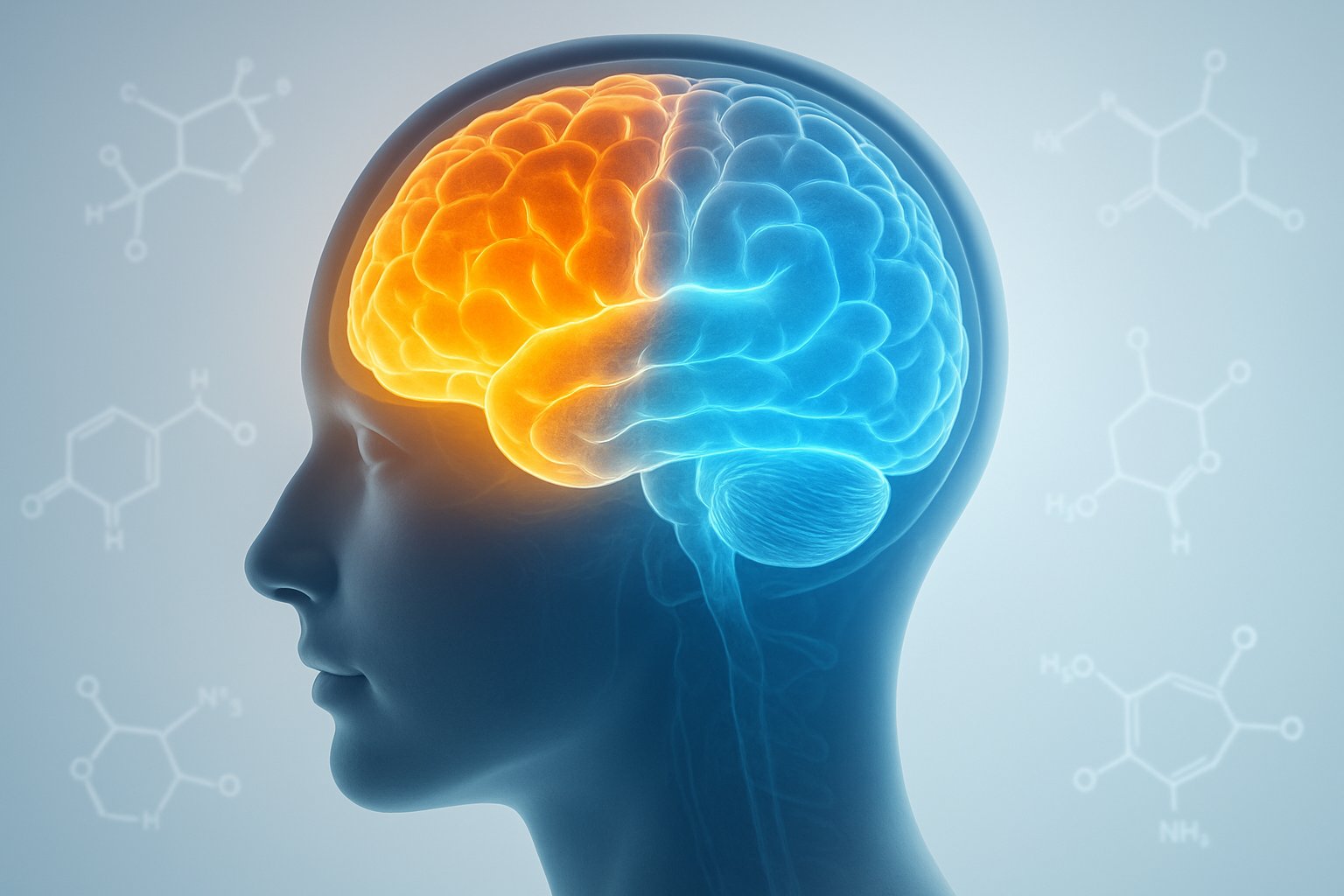
Dopamine acts as the brain’s primary driver for goal-seeking behavior and creates feelings of satisfaction when rewards are achieved. This neurotransmitter directly controls energy levels, focus, and the ability to pursue long-term objectives.
Role in Motivation and Reward System
Dopamine functions as the brain’s motivation and reward neurotransmitter, controlling drive and goal-setting behaviors. It activates before achieving rewards, not just during pleasurable experiences.
The reward system releases dopamine when people anticipate positive outcomes. This creates the push needed to take action toward goals. Without adequate dopamine levels, individuals struggle with motivation and completing tasks.
Key functions in motivation:
- Encourages goal-setting and planning
- Provides energy for sustained effort
- Creates anticipation for future rewards
- Drives competitive behaviors
People with healthy dopamine function show consistent motivation patterns. They can start projects, maintain focus, and push through challenges to reach their objectives.
Influence on Focus and Learning
Dopamine significantly impacts concentration abilities and learning processes. Higher dopamine levels improve attention span and help filter out distractions during important tasks.
The neurotransmitter strengthens memory formation when new information connects to rewarding experiences. This explains why people remember enjoyable learning situations better than boring ones.
Focus-related benefits:
- Enhanced attention to detail
- Better working memory function
- Improved task switching abilities
- Increased mental alertness
ADHD often involves dopamine imbalances that affect focus and learning. Treatments that boost dopamine activity help improve concentration in these individuals.
Learning and memory systems depend on dopamine to mark important information worth remembering. Students with balanced dopamine levels typically show better academic performance.
Pleasure and Reinforcement
Dopamine drives pleasure-seeking behaviors and reinforces actions that lead to positive outcomes. It creates the satisfaction feeling when people complete goals or experience enjoyable activities.
The reinforcement process happens automatically. When actions produce good results, dopamine strengthens the neural pathways that led to those behaviors.
Common dopamine triggers:
- Completing tasks successfully
- Eating favorite foods
- Social interactions
- Physical exercise
- Creative activities
This system can become problematic with substance abuse and addiction. Drugs artificially spike dopamine levels, creating powerful cravings for repeated use.
Healthy reinforcement patterns support beneficial habits. Regular exercise, productive work, and meaningful relationships all activate dopamine in balanced ways.
Signs of Dopamine Imbalance
Low dopamine levels create noticeable changes in motivation, energy, and mood. People may struggle with basic daily tasks and lose interest in previously enjoyable activities.
Low dopamine symptoms:
- Lack of motivation and drive
- Difficulty concentrating
- Low energy levels
- Reduced pleasure in activities
- Procrastination problems
- Sleep disturbances
High dopamine can lead to excessive risk-taking and addictive behaviors. Some individuals become overly focused on reward-seeking at the expense of responsibilities.
Dopamine deficiency plays a role in conditions like Parkinson’s disease, depression, and ADHD. These disorders often improve with treatments that restore proper dopamine function.
Creativity often correlates with dopamine activity. Artists and innovators frequently show unique dopamine patterns that support novel thinking and sustained creative effort.
Interplay Between Serotonin and Dopamine in Mental Health
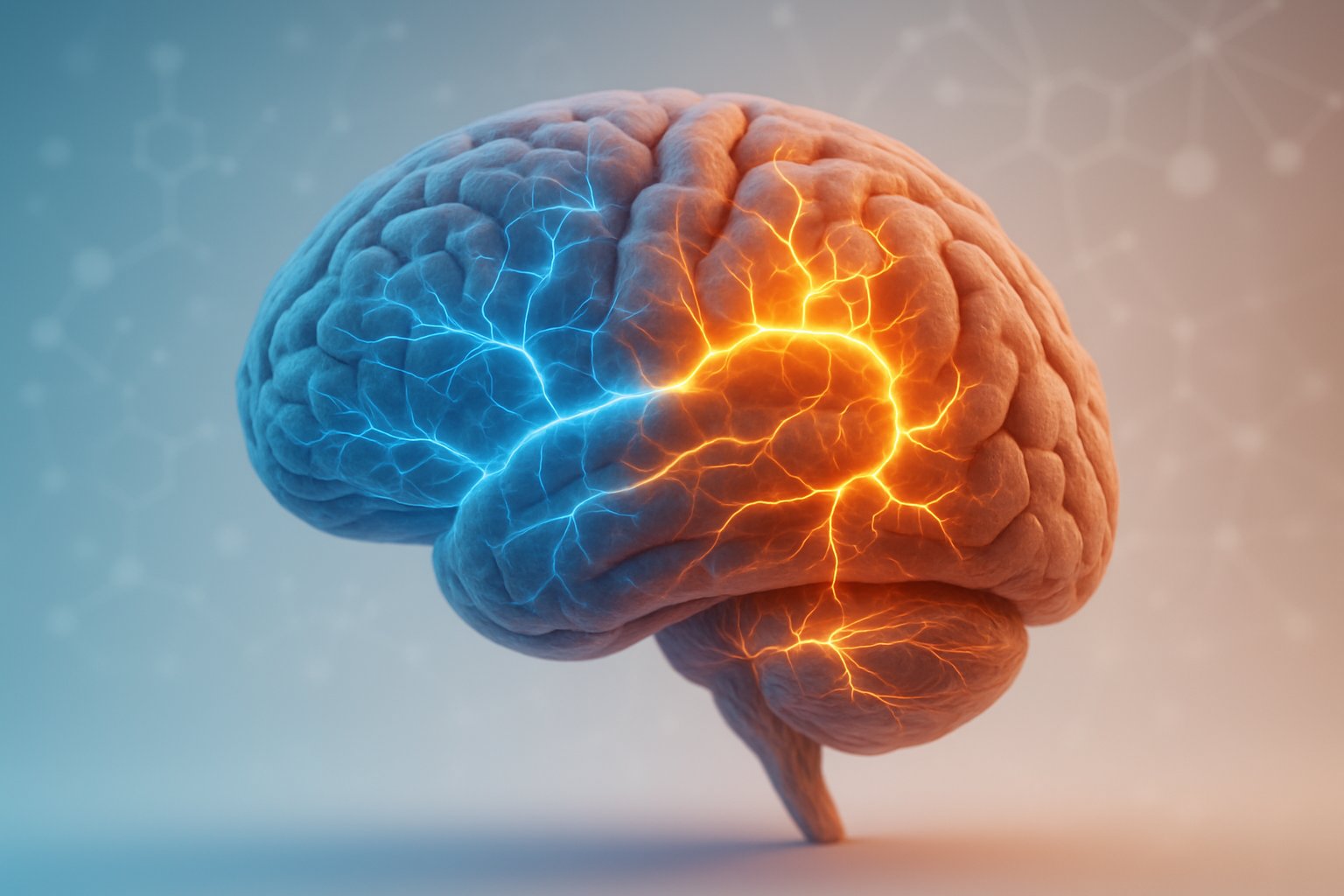
Serotonin and dopamine work together in complex ways to maintain mental wellness. When these brain chemicals become imbalanced, they can contribute to mood disorders, stress responses, and various psychological conditions.
Mood Disorders and Emotional Balance
Mental health professionals recognize that mood disorders rarely involve just one neurotransmitter. Depression can result from low levels of both serotonin and dopamine, creating different symptom patterns in affected individuals.
Serotonin-dominant depression typically includes:
- Persistent sadness and hopelessness
- Sleep disturbances and appetite changes
- Difficulty feeling satisfied or content
Dopamine-related depression often presents as:
- Loss of motivation and interest
- Inability to feel pleasure
- Reduced energy for daily activities
Many people experience mixed presentations where both systems are disrupted. This explains why some individuals need medications that target multiple neurotransmitters rather than just one.
The brain’s reward and mood circuits depend on both chemicals working in harmony. Dopamine drives the initial motivation to seek rewarding experiences, while serotonin helps process and maintain emotional satisfaction from those experiences.
Stress, Anxiety, and Depression
Chronic stress disrupts the delicate balance between serotonin and dopamine through elevated cortisol levels. High cortisol can reduce the production and effectiveness of both neurotransmitters over time.
Stress Response Patterns:
- Short-term stress may temporarily increase dopamine to enhance focus
- Chronic stress depletes both serotonin and dopamine reserves
- Cortisol elevation interferes with neurotransmitter synthesis
Anxiety disorders often involve serotonin dysfunction in brain regions that regulate fear and worry. When serotonin levels drop, the brain becomes more reactive to perceived threats and less able to maintain calm states.
Depression frequently shows dopamine deficits in motivation and reward pathways. People may lose interest in activities they once enjoyed because their brains cannot generate the same rewarding feelings.
The combination creates a cycle where stress reduces neurotransmitter function, leading to mood symptoms that generate more stress.
Implications for Mental Health Issues
Understanding how serotonin and dopamine interact helps explain why mental health treatment often requires comprehensive approaches. The balance between these neurotransmitters affects overall emotional well-being and determines treatment effectiveness.
Treatment Considerations:
- Some antidepressants target both serotonin and dopamine systems
- Therapy helps develop coping skills that support neurotransmitter balance
- Lifestyle changes can naturally boost both chemicals simultaneously
Dual-system disorders may require medications that address multiple neurotransmitter pathways. This explains why some people respond better to certain drug combinations than others.
Recovery patterns often show improvement in different symptoms at different rates. Motivation and energy may return before mood fully stabilizes, or vice versa.
Mental health professionals increasingly recognize that effective treatment must consider the complex interactions between brain chemistry systems rather than focusing on individual neurotransmitters in isolation.
Natural Ways to Support Healthy Neurotransmitter Levels
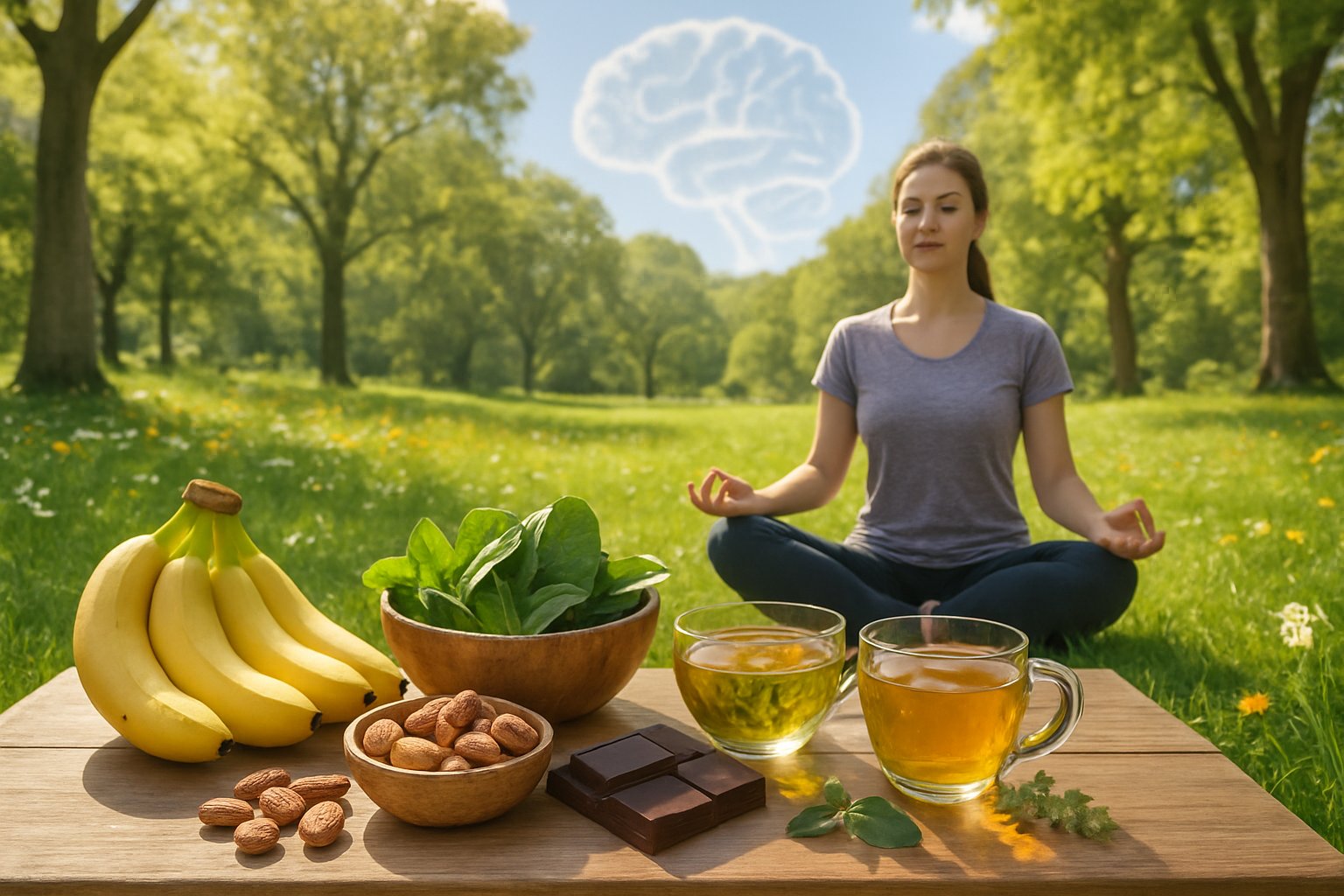
Several proven strategies can help maintain optimal serotonin and dopamine levels through daily lifestyle choices. These methods focus on exercise, targeted nutrition, quality sleep, and stress management techniques that work with your body’s natural chemistry.
Exercise and Physical Activity
Regular physical activity serves as one of the most effective ways to boost both serotonin and dopamine naturally. Exercise triggers the release of endorphins and other feel-good chemicals that create lasting mood improvements.
The phenomenon known as runner’s high occurs when intense physical activity floods the brain with endorphins and dopamine. This natural high can last for hours after a workout ends.
Effective exercise types include:
- Aerobic activities like running, cycling, or swimming
- Strength training with weights or resistance bands
- Yoga and stretching routines
- Dancing or group fitness classes
Even moderate exercise for 20-30 minutes can produce measurable changes in neurotransmitter levels. The key lies in consistency rather than intensity.
Diet and Nutritional Factors
Food choices directly impact the brain’s ability to produce serotonin and dopamine. Protein-rich foods provide amino acids that serve as building blocks for these neurotransmitters.
Tryptophan, found in turkey, eggs, and cheese, converts directly into serotonin in the brain. The amino acid tyrosine from meat and fish helps create dopamine.
Key nutrients for neurotransmitter production:
| Nutrient | Food Sources | Supports |
|---|---|---|
| Tryptophan | Turkey, eggs, salmon | Serotonin production |
| Tyrosine | Beef, tuna, almonds | Dopamine synthesis |
| Magnesium | Dark leafy greens, nuts | GABA function |
| Omega-3 fatty acids | Fish, walnuts, flaxseeds | Overall brain health |
Complex carbohydrates from whole grains help transport tryptophan across the blood-brain barrier more effectively.
Sleep Hygiene and Recovery
Quality sleep plays a crucial role in maintaining balanced neurotransmitter levels. Poor sleep corresponds to decreased dopamine receptor function, leading to daytime sluggishness and mood problems.
Dopamine naturally signals the body to wake up while reducing melatonin levels. This system only works properly when sleep patterns remain consistent.
Sleep optimization strategies:
- Maintain regular bedtime and wake times
- Create a dark, cool sleeping environment
- Limit screen time 2 hours before bed
- Use magnesium supplements to support GABA receptors
Most adults need 7-9 hours of uninterrupted sleep for optimal neurotransmitter balance. Sleep debt cannot be easily repaid on weekends.
Managing Stress and Lifestyle Habits
Chronic stress elevates cortisol levels, which can suppress both serotonin and dopamine production. Simple daily practices can help counteract stress-related neurotransmitter depletion.
Laughter naturally increases endorphin release by contracting abdominal muscles similar to vigorous exercise. Watching comedy or spending time with funny friends provides measurable mood benefits.
Stress-reducing activities include:
- Deep breathing exercises or meditation
- Listening to enjoyable music
- Spending time in nature or sunlight
- Engaging in creative hobbies
Light therapy can boost serotonin levels during darker months when seasonal depression becomes more common. Even 15-20 minutes of morning sunlight exposure helps regulate natural circadian rhythms.
Related Happy Chemicals: Oxytocin and Endorphins
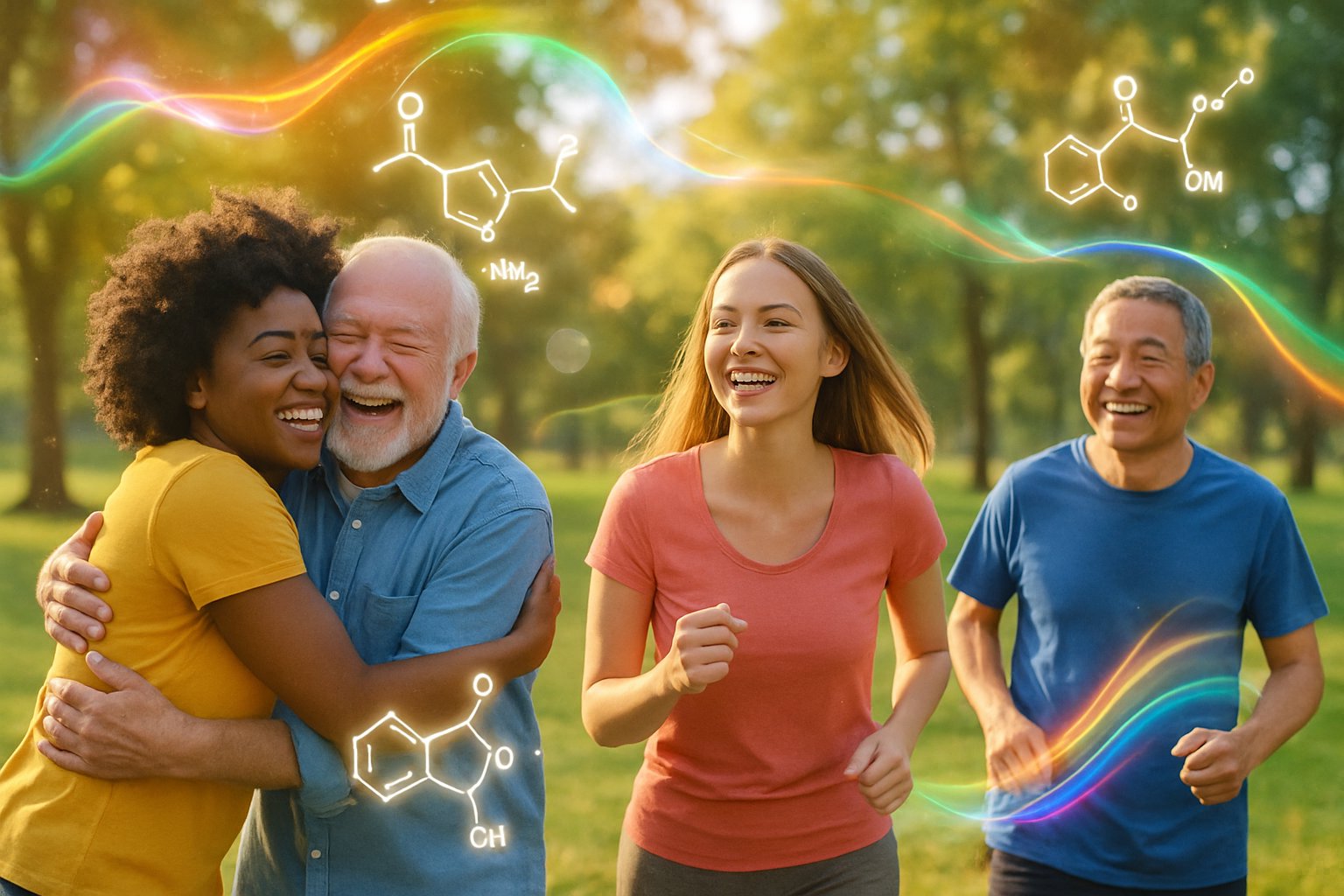
While serotonin and dopamine handle mood regulation and motivation, oxytocin strengthens social bonds and trust, and endorphins provide natural pain relief during stress or discomfort. These chemicals work together with serotonin and dopamine to create complex emotional experiences.
Oxytocin: The Love Hormone
Oxytocin earned its nickname as the “love hormone” because it plays a key role in bonding and social interactions. The brain releases this chemical during physical touch, childbirth, and intimate moments.
This hormone builds trust between people. It helps parents bond with their children and strengthens romantic relationships.
Oxytocin also influences how people interact in groups. Higher levels make individuals more generous and cooperative with others.
Key triggers for oxytocin release:
- Hugging and physical contact
- Eye contact with loved ones
- Acts of kindness
- Petting animals
- Massage therapy
Research shows that oxytocin can impact dopamine pathways to enhance feelings of reward. This connection explains why social bonding feels so rewarding to humans.
Endorphins: Natural Painkillers
Endorphins function as the body’s built-in pain relief system. These chemicals have a structure similar to morphine but are produced naturally by the brain.
The body releases endorphins during times of stress, pain, or intense physical activity. They help people push through difficult situations by reducing discomfort.
Common endorphin triggers include:
- Exercise and physical exertion
- Eating spicy foods
- Laughing
- Sexual activity
- Listening to music
Athletes often experience an “endorphin rush” during intense workouts. This creates feelings of euphoria that can last for hours after exercise ends.
Spicy foods containing capsaicin also trigger endorphin release as the body responds to the burning sensation. Dark chocolate can produce similar effects.
Interactions with Serotonin and Dopamine
These four chemicals rarely work alone. They create complex patterns that shape human emotions and behaviors.
Oxytocin and dopamine work together during social bonding. When someone feels close to another person, both chemicals activate reward pathways in the brain.
Endorphins can enhance the effects of serotonin during positive experiences. Someone enjoying a spicy meal with friends benefits from both endorphin release and serotonin’s mood-stabilizing effects.
Chemical interactions:
| Combination | Effect | Example |
|---|---|---|
| Oxytocin + Dopamine | Enhanced social rewards | Falling in love |
| Endorphins + Serotonin | Improved mood during stress | Post-workout happiness |
| All four together | Peak happiness states | Celebrating with loved ones |
The balance between these chemicals determines emotional well-being. Too much or too little of any one chemical can disrupt the entire system.
The Role of Brain Chemistry in Relationships and Social Well-Being
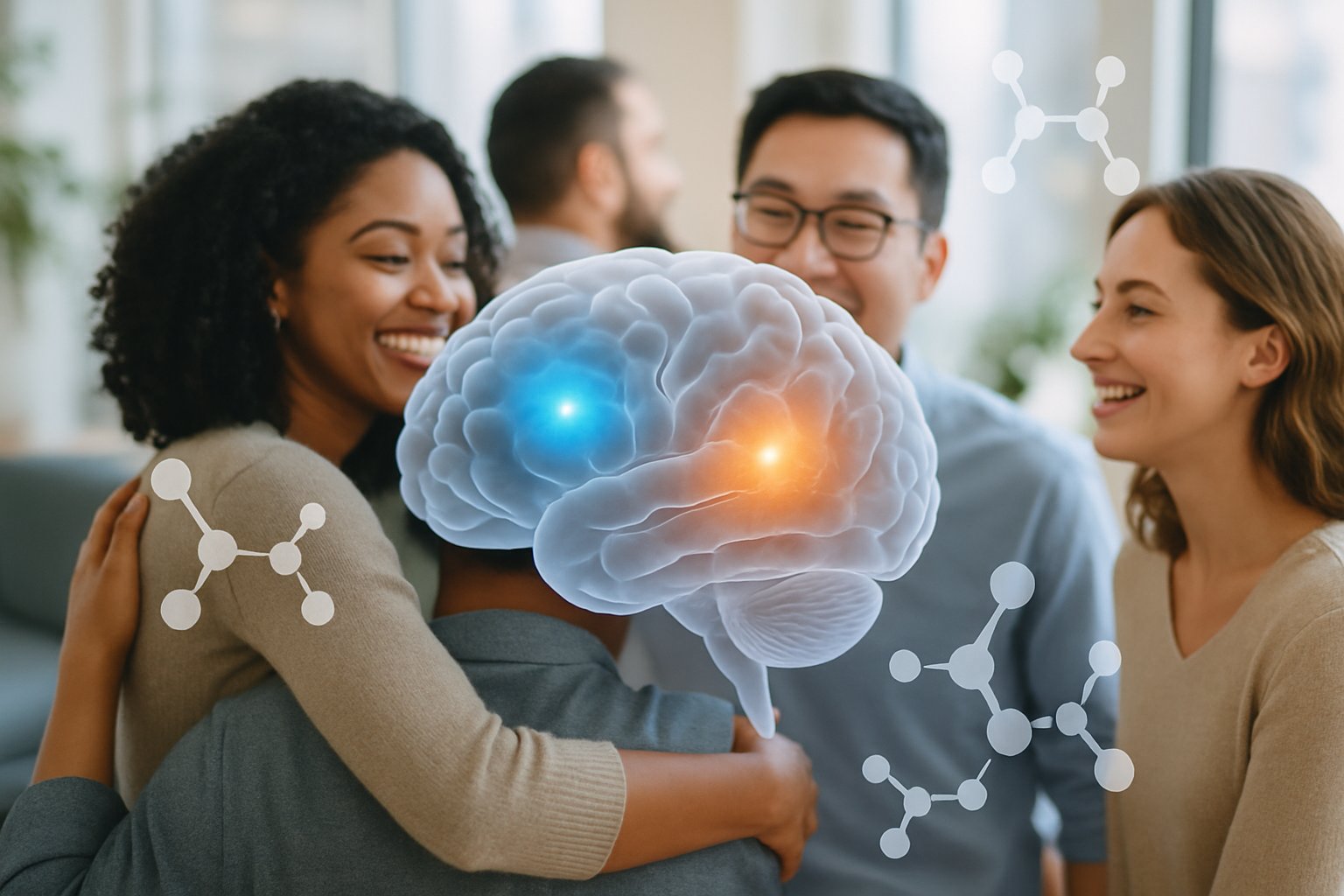
Serotonin and dopamine work together to shape how people connect with others and experience emotional satisfaction. These brain chemicals control attraction, bonding behaviors, and the ability to maintain healthy social relationships.
Impact on Relationships and Bonding
Brain chemistry plays a crucial role in forming and maintaining romantic relationships. When people first meet someone, their brain releases dopamine, serotonin and norepinephrine, creating feelings of motivation, desire, and pleasure.
Dopamine drives the reward-seeking behavior that fuels attraction. It makes people want to spend more time with someone they find appealing. This chemical creates the excitement and anticipation felt in new relationships.
Serotonin helps stabilize mood and emotional well-being during bonding. Higher serotonin levels promote feelings of contentment and security with a partner. Lower levels can lead to relationship anxiety and emotional instability.
Key bonding chemicals:
- Dopamine: Creates excitement and motivation to pursue connection
- Serotonin: Maintains emotional stability and contentment
- Oxytocin: Builds trust and attachment over time
The balance between these chemicals determines relationship satisfaction. People with healthy neurotransmitter levels typically form stronger, more stable bonds with others.
Social Behavior and Emotional Health
Research shows that dopamine and serotonin play distinct roles in processing social context during decision-making. These chemicals influence how people interact with others and respond to social situations.
Dopamine tracks whether social interactions are better or worse than previous experiences. It acts like a continuous monitoring system that helps people learn from social encounters. Higher dopamine levels occur when fairness becomes important in social situations.
Serotonin focuses on evaluating the current value of specific social interactions. It provides a case-by-case assessment of whether a social situation feels rewarding or threatening.
Social behavior patterns:
- People make different decisions with humans versus computers
- Fairness considerations activate specific brain chemistry responses
- Social context changes how rewards are processed
Brain chemistry influences social behavior by creating neurochemical mechanisms that guide social decision-making. Imbalanced neurotransmitters can lead to social anxiety, depression, or difficulty maintaining relationships.
Healthy Habits for Emotional Well-Being
Several lifestyle choices can support healthy brain chemistry and improve social well-being. Regular exercise increases both serotonin and dopamine production naturally.
Exercise benefits:
- Boosts mood-regulating neurotransmitters
- Reduces stress hormones
- Improves sleep quality
- Enhances social confidence
Social connections themselves help maintain brain chemistry balance. Positive relationships provide regular opportunities for healthy neurotransmitter release. Isolation can disrupt these chemical systems over time.
Adequate sleep supports proper neurotransmitter function. Sleep deprivation reduces serotonin production and impairs dopamine sensitivity. Most adults need 7-9 hours of quality sleep nightly.
Daily habits for brain health:
- Maintain regular sleep schedule
- Engage in physical activity
- Spend time with supportive people
- Practice stress management techniques
- Eat balanced meals with protein
Brain health significantly impacts stress regulation and social connection. People who prioritize these habits typically experience better emotional health and stronger relationships. Small daily changes can create meaningful improvements in brain chemistry over time.
Factors That Disrupt Neurotransmitter Balance
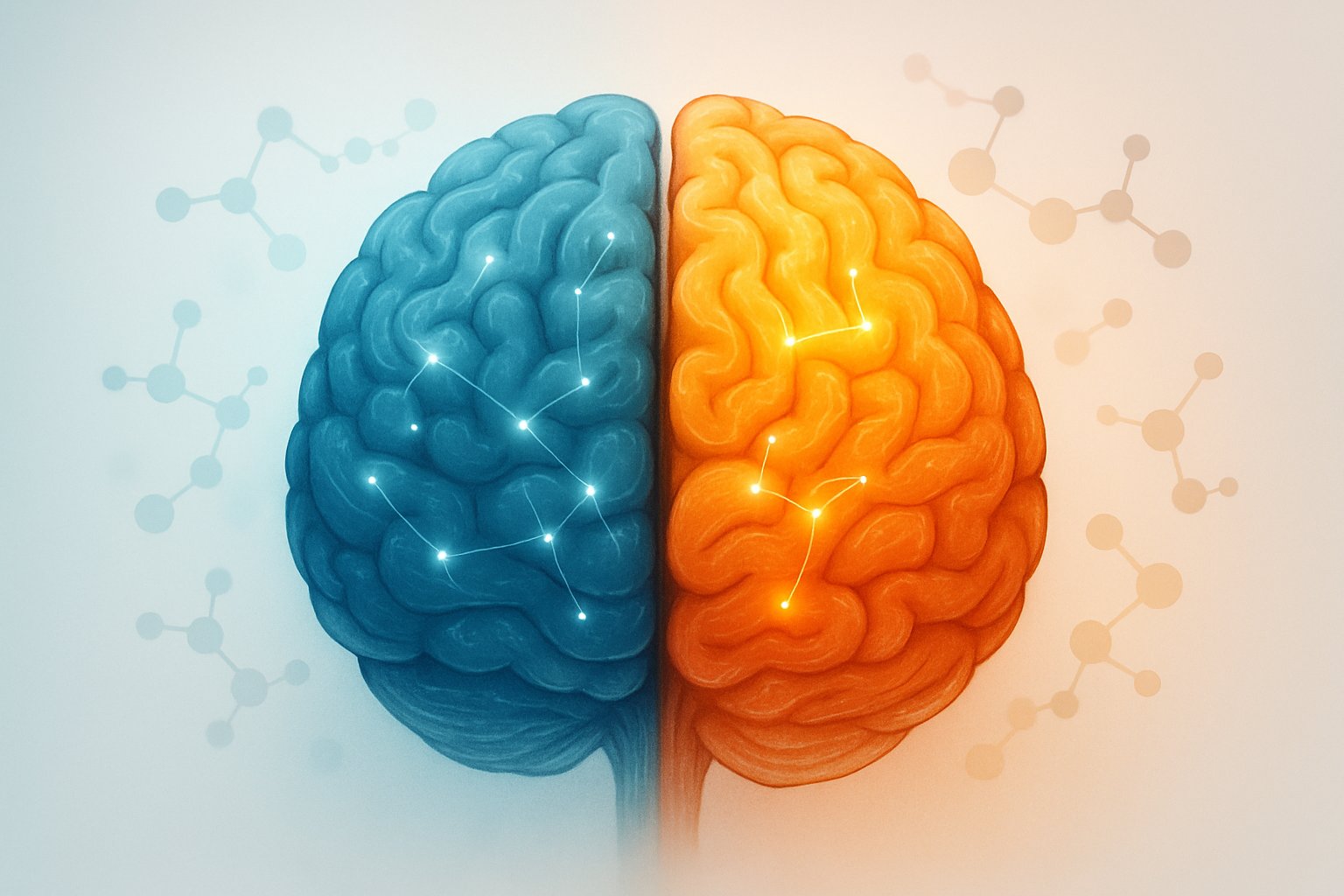
Multiple factors can throw serotonin and dopamine levels off balance, leading to mood changes and health problems. Age-related brain changes, poor sleep patterns, substance use, and untreated mental health issues all play major roles in disrupting these important brain chemicals.
Aging and Brain Chemistry
The brain naturally produces less serotonin and dopamine as people get older. After age 40, dopamine production drops by about 10% each decade.
This decline explains why older adults often experience decreased motivation and energy levels. The brain’s ability to respond to these chemicals also weakens with age.
Common age-related changes include:
- Slower neurotransmitter production
- Reduced receptor sensitivity
- Increased breakdown of brain chemicals
- Changes in sleep patterns that affect balance
Regular exercise and social activities can help slow these changes. Mental health conditions like depression become more common as neurotransmitter levels drop naturally with aging.
Sleep Disorders and Insomnia
Poor sleep directly disrupts both serotonin and dopamine production. The brain makes most of these chemicals during deep sleep stages.
Chronic insomnia creates a harmful cycle. Low serotonin makes it harder to fall asleep, while lack of sleep further reduces serotonin production.
Sleep problems affect neurotransmitters by:
- Blocking natural chemical restoration
- Disrupting circadian rhythms
- Reducing REM sleep quality
- Increasing stress hormone levels
People with insomnia often struggle with mood swings and lack of motivation. Serotonin helps the body make melatonin, the main sleep hormone, creating strong connections between sleep and mood.
Effects of Substance Abuse
Alcohol and drugs severely disrupt normal serotonin and dopamine function. These substances create artificial highs by flooding the brain with chemicals.
Regular substance use forces the brain to reduce its natural production. This leads to tolerance, where people need more of the substance to feel normal effects.
Substance abuse causes:
- Depleted natural neurotransmitter stores
- Damaged brain receptors
- Increased depression and anxiety
- Physical dependence and addiction
Recovery requires time for the brain to restore normal chemical balance. Cannabis use may temporarily increase neurotransmitter levels but long-term use can suppress dopamine production.
Risks of Imbalance and When to Seek Help
Severe neurotransmitter imbalances can lead to serious mental health problems. Depression, anxiety disorders, and addiction often result from disrupted brain chemistry.
Warning signs that require professional help:
- Persistent sadness lasting weeks
- Complete loss of interest in activities
- Thoughts of self-harm
- Inability to function at work or home
- Severe mood swings
Early treatment prevents problems from getting worse. Mental health professionals can prescribe medications and suggest lifestyle changes to restore balance.
Medical conditions like Parkinson’s disease also cause dopamine deficiency and require specialized treatment. People should seek help when symptoms interfere with daily life for more than two weeks.
Frequently Asked Questions
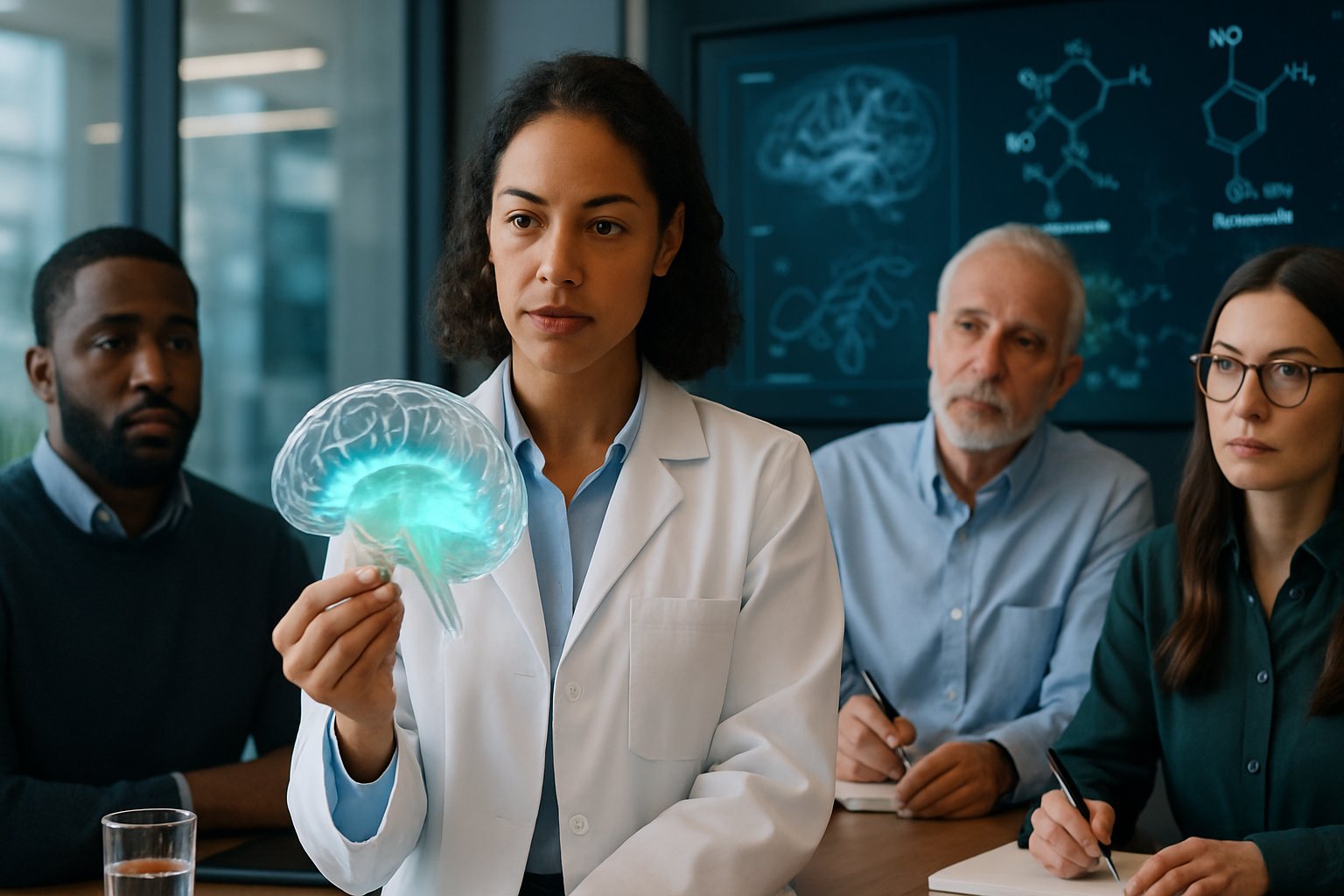
These brain chemicals affect mood differently and work through separate pathways in the brain. People can naturally increase both chemicals through lifestyle changes and specific activities.
What are the differences between serotonin and dopamine in terms of their impact on mood?
Serotonin helps create feelings of calm, contentment, and emotional stability. It works like a mood stabilizer that keeps emotions balanced throughout the day.
Dopamine focuses on motivation, reward, and pleasure-seeking behaviors. When dopamine levels rise, people feel excited and driven to pursue goals.
Low serotonin often leads to anxiety, sadness, and feeling emotionally unstable. Low dopamine creates lack of motivation, boredom, and inability to feel pleasure from activities.
How do serotonin and dopamine contribute to feelings of happiness and well-being?
Serotonin creates satisfaction, joy, and empathy for other people. It helps people feel content with their current situation and maintains steady emotional well-being.
Dopamine drives the brain’s reward system and creates feelings of euphoria when people achieve goals. It makes activities feel enjoyable and motivates people to repeat rewarding behaviors.
Both chemicals work together to create different types of happiness. Serotonin provides peaceful contentment while dopamine creates excitement and pleasure.
Can an imbalance between serotonin and dopamine levels lead to depression?
Both neurotransmitters can affect mood disorders like depression. Low levels of either chemical can cause specific depression symptoms.
Low dopamine causes lack of motivation, difficulty concentrating, and loss of interest in enjoyable activities. People may feel hopeless and unable to experience pleasure.
Low serotonin levels may increase depression risk. Many depression treatments use medications that increase serotonin availability in the brain.
Depression involves multiple factors beyond brain chemistry. Genetics, stress levels, environment, and medical conditions also play important roles.
What natural methods are available to boost serotonin and dopamine levels in the body?
Regular exercise increases both serotonin and dopamine production. Physical activity triggers the release of these chemicals and improves mood within hours.
Eating foods with tryptophan helps the body make more serotonin. Turkey, eggs, salmon, and pumpkin seeds contain high amounts of this protein.
Getting enough sleep allows the brain to properly regulate both chemicals. Poor sleep disrupts neurotransmitter production and balance.
Meditation and mindfulness practices naturally boost serotonin levels. These activities help reduce stress and promote emotional stability.
Completing small goals and celebrating achievements increases dopamine. Breaking large tasks into smaller steps provides regular dopamine boosts.
How can one measure the levels of serotonin and dopamine in the body?
Direct measurement of brain serotonin and dopamine levels is not possible in living people. These chemicals work inside the brain where doctors cannot easily test them.
Blood tests can measure serotonin in the body, but most serotonin exists in the gut rather than the brain. Blood serotonin levels do not accurately reflect brain serotonin.
Doctors typically diagnose neurotransmitter imbalances through symptoms and behavior patterns. They look for signs like mood changes, sleep problems, and motivation issues.
Some urine tests claim to measure neurotransmitter levels, but these tests are not scientifically reliable. Brain chemistry cannot be accurately measured through urine samples.
What is the role of other happiness hormones like oxytocin and endorphins in relation to serotonin and dopamine?
Oxytocin works as the “love hormone” and helps build relationships and social bonds. It creates feelings of trust, connection, and attachment to other people.
Endorphins act as natural pain relievers and create feelings of well-being. The body releases endorphins during exercise, laughter, and stressful situations.
All four chemicals work together to create different aspects of happiness and well-being. Each one serves a specific purpose in maintaining mental and emotional health.
These four chemicals are often called the “happy hormones” because they all promote positive feelings and mental wellness in different ways.